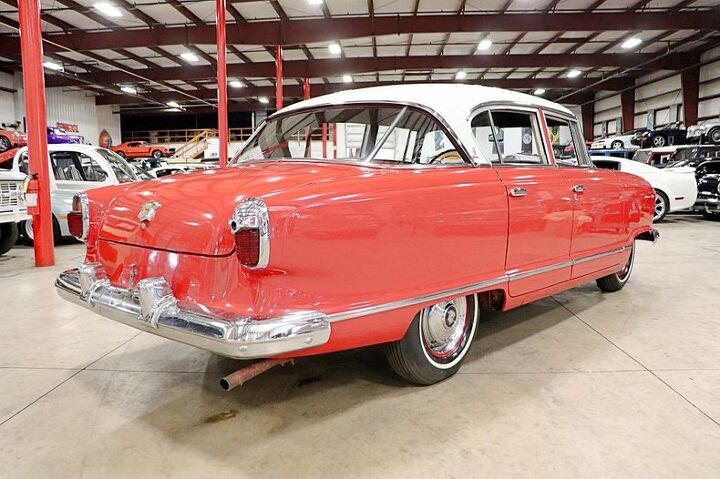Rare Rides: The Unique Looking 1955 Nash Statesman

About a year ago Rare Rides featured its first Nash, the tiny Metropolitan. Today we take a look at the full-size car that occupied the showroom floor alongside its smallest sibling.
Hailing from 1955, it’s a Statesman.
Though a large car, the Statesman was not the flagship automobile at Nash. That honor was reserved for the Ambassador, which rode on a longer wheelbase, and was always a larger car than the Statesman. A first-generation Statesman was produced in 1950 and 1951, as the company debuted its new and aerodynamic fastback styling dubbed Airflyte. Featuring fully skirted fenders as a signature, engineers at Nash had to make some adjustments in the name of style. On the Ambassador the front track was three inches narrower than at the rear (to maintain a reasonable turning circle).
A new generation debuting for the 1952 model year saw Nash modernize Airflyte into the so-called “envelope body.” To assist with the design, they called up Pininfarina. Sheet metal was more upright and more voluminous, and some of the bathtub curves of the prior model were turned into creases. As before, Statesman was available with two doors as a sedan or hardtop, and as a four-door pillared sedan.
Nash was all about saving money, so it continued using the inline-six engines it developed in the 1920s. The unique design lacked intake and exhaust manifolds, which meant the engine was simpler, had fewer parts, and was thus lighter. Fuel efficiency was one of the selling points of the Statesman. Between generations one and two, the marque did up engine displacement slightly, going from 3.0 to 3.2 liters.
Changes in 1954 included a continental kit to increase trunk space, and one final moment of independence for Nash. On May 1, 1954, Nash-Kelvinator and Hudson merged to become American Motors. Consolidation was inevitable, and the Statesman was one of the first products to go. 1956 was the Statesman’s final year, as in ’57 the only full-size Nash offering was the Ambassador. That lasted exactly one year before the Ambassador was dropped, as well.
The Ambassador name continued the following year on a new AMC.
Today’s Rare ride is in solid condition, though not show quality at the moment. Then again, it doesn’t ask a show quality price: With 48,000 miles, it’s for sale at $9,900.
[Images: seller]

Interested in lots of cars and their various historical contexts. Started writing articles for TTAC in late 2016, when my first posts were QOTDs. From there I started a few new series like Rare Rides, Buy/Drive/Burn, Abandoned History, and most recently Rare Rides Icons. Operating from a home base in Cincinnati, Ohio, a relative auto journalist dead zone. Many of my articles are prompted by something I'll see on social media that sparks my interest and causes me to research. Finding articles and information from the early days of the internet and beyond that covers the little details lost to time: trim packages, color and wheel choices, interior fabrics. Beyond those, I'm fascinated by automotive industry experiments, both failures and successes. Lately I've taken an interest in AI, and generating "what if" type images for car models long dead. Reincarnating a modern Toyota Paseo, Lincoln Mark IX, or Isuzu Trooper through a text prompt is fun. Fun to post them on Twitter too, and watch people overreact. To that end, the social media I use most is Twitter, @CoreyLewis86. I also contribute pieces for Forbes Wheels and Forbes Home.
More by Corey Lewis
Latest Car Reviews
Read moreLatest Product Reviews
Read moreRecent Comments
- ToolGuy 9 miles a day for 20 years. You didn't drive it, why should I? 😉
- Brian Uchida Laguna Seca, corkscrew, (drying track off in rental car prior to Superbike test session), at speed - turn 9 big Willow Springs racing a motorcycle,- at greater speed (but riding shotgun) - The Carrousel at Sears Point in a 1981 PA9 Osella 2 litre FIA racer with Eddie Lawson at the wheel! (apologies for not being brief!)
- Mister It wasn't helped any by the horrible fuel economy for what it was... something like 22mpg city, iirc.
- Lorenzo I shop for all-season tires that have good wet and dry pavement grip and use them year-round. Nothing works on black ice, and I stopped driving in snow long ago - I'll wait until the streets and highways are plowed, when all-seasons are good enough. After all, I don't live in Canada or deep in the snow zone.
- FormerFF I’m in Atlanta. The summers go on in April and come off in October. I have a Cayman that stays on summer tires year round and gets driven on winter days when the temperature gets above 45 F and it’s dry, which is usually at least once a week.








































Comments
Join the conversation
Did some googling and found this '55 Wasp, A commenter says Hudson called the pink color "palomino". https://www.curbsideclassic.com/blog/cohort-sighting-1955-hudson-wasp-hash-anyone/ Also for good measure here is a nice '55 Chev with salmon,gray inside and out :). https://www.curbsideclassic.com/curbside-classics-american/curbside-classic-1955-chevrolet-the-icar/
Fender skirts doom the parent company. Front pseudo-skirts accelerate the process. [First body-colored B-pillar I've seen in awhile. And those 'shock towers' look... stiff.]